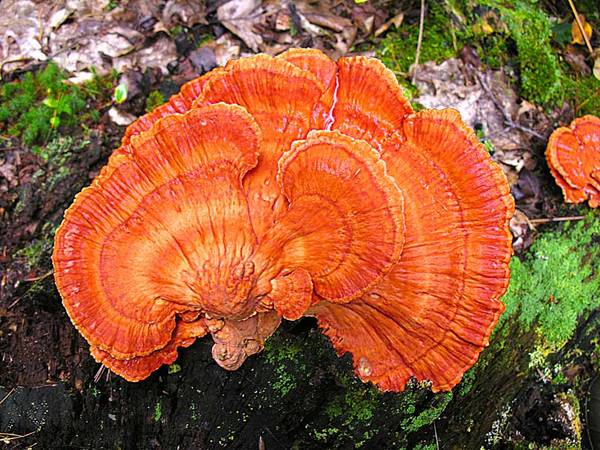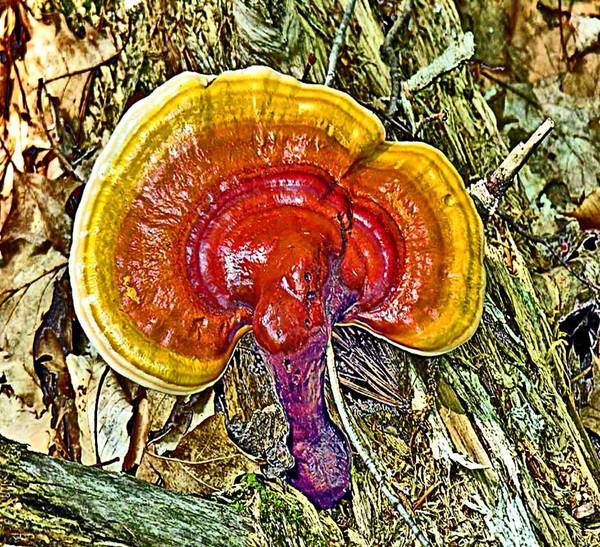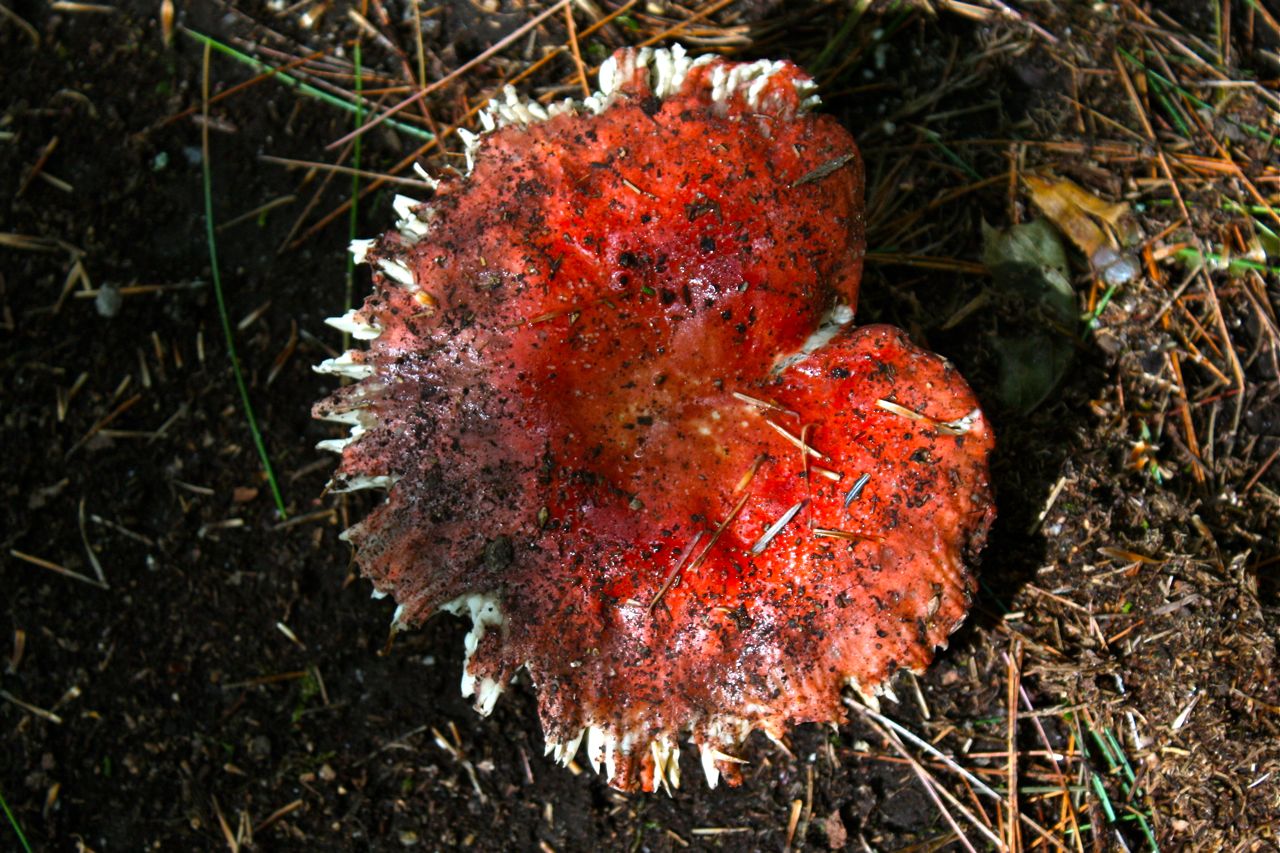I searched
Winnipesaukee.com's Photo Gallery for mushrooms for your viewing enjoyment.
Click on the name under the picture to go into the gallery, where you can click on the picture for a super-sized version for more detail.
dcr gets top billing because he actually knows what he took photographs of!

I also included his photo descriptions for your information.
Webmaster, it just might be time to add another category to Photopost for flora and fungi!

Thanks for providing such an excellent gallery for us!
 A Colorful Woodland Phenomenon
From the gallery of dcr
A Colorful Woodland Phenomenon
From the gallery of dcr
dcr's description:
Yesterday, while walking through Weeks Woods in Gilford, I came upon these bright-orange mushrooms growing on an old stump. Not only are they a bright orange, but they appear to have a 'varnished' surface, which gives them very high visibility, even on a day as dark and gloomy as yesterday was. The next posting has a discussion of what species they might be.
 Knowledgeable Mycologist Needed
From the gallery of dcr
Knowledgeable Mycologist Needed
From the gallery of dcr
dcr's description:
I've found my effort to identify this mushroom from the web to be rather frustrating. There are at least 3 different species that look something like, but not precisely like, the speciman I'm concerned with: Laetiporus sulphureus (Chicken mushroom or Chicken-of-the- woods), which is edible and apparently reminds users of chicken; Trametes versicolor (Turkey tail - looks like a fanned out turkey's tail as seen during their mating season) - the word versicolor suggests that these mushrooms come in various colors, including orange, and this does look something like a turkey tail; Stereum hirsutum (False turkey tail) - looks similar to the previous example, but has some distinct properties of its own. Primarily because the web suggests that Trametes versicolor is the most common of the 3, I'll suggest that that is the species we see here. What is more important is that the speciman is an extremely colorful addition to the beauty to be enjoyed while walking through our local woodlands.
 A Halloween Fungus
From the gallery of dcr
A Halloween Fungus
From the gallery of dcr
dcr's description:
This fungus, seen growing on an injured and dying oak tree beside a trail at Castle in the Clouds, has the orange and yellow colors typical of Halloween. My best guess is that it is a polypilus frondosus (known commonly as Hen-of the Woods) - if true then it is considered edible and choice by mushroom connoisseurs, but only at a stage much younger than this (now it is quite woody in texture). However, some mushrooms can be lethal if eaten, so one should not experiment with them without an expert's advice - a mistaken identification can be deadly at worst, or highly uncomfortable at best.
 Ganoderma lucidum or Lacquered Polypore
From the gallery of dcr
Ganoderma lucidum or Lacquered Polypore
From the gallery of dcr
dcr's description:
When very young this fungus is Chinese Red, bright yellow and white - later the white and yellow disappear. Not edible, but it is reputed to have the potential for great efficacy in the treatment of Alzheimers, cardiovascular disease, cancer and more - not yet proven, but is under study. An Asian variety (called Reishi or Ling Chi) has been used in China and Japan for centuries for enhancing vital energy, improving memory (and virility) and thinking power, and increasing lifespan. You can find multiple web sites touting its many supposed powers - if it proved useful in treating even a small fraction of these ailments, it would become a miracle plant. Photo taken on Stonedam Island last summer. I'm not even an amateur mycologist, but my web research makes me fairly confident that I've identified this correctly.
 Rand Cliff-Natural Arch on Path Out
From the gallery of dcr
Rand Cliff-Natural Arch on Path Out
From the gallery of dcr
dcr's description:
When hiking the trail from Rand Cliff out, the natural arch created by rock falls from the cliff, which the trail passes under, looks like this as you approach it. If you're 6 ft or more tall you have to duck a little to get under the near part of the arch roof. Note the plant growth on the huge boulder at the left - that is a plant partnership between a fungus and an alga (to form a lichen), the first providing the food (energy) for the plant, and the second providing protection, water conservation, etc. This plant is known as Rock Tripe, a reference to the fact that it had been used by native Americans and early white explorers of this continent as an emergency or starvation food in times of crisis - tripe suggests that it is edible, but not especially palatable (and causes some people serious digestive distress - but that is better than starvation). The fungal element can store water and thus exist without rain for a year or more - during periods when water is plentiful the plant is soft & its color is greenish, but when drought occurs it turns leathery in texture and becomes brownish. Rock Tripe -
http://www.sierrapotomac.org/W_Needh...ipe_080211.htm
 Rainy day mushroom
From the gallery of Jonas Pilot
Rainy day mushroom
From the gallery of Jonas Pilot
 Wild Mushrooms
From the gallery of Rattlesnake Gal
Wild Mushrooms
From the gallery of Rattlesnake Gal
 Three Mushrooms!
From the gallery of Rattlesnake Gal
Three Mushrooms!
From the gallery of Rattlesnake Gal

The next stage of a tree
From the gallery of Jonas Pilot

Rattlesnake Island Shroom
From the gallery of Rattlesnake Gal
 Late summer mushroom
From the gallery of Jonas Pilot
Late summer mushroom
From the gallery of Jonas Pilot
 Trumpet-Style Mushrooms
From the gallery of Rattlesnake Gal
Trumpet-Style Mushrooms
From the gallery of Rattlesnake Gal
 Mushroom season
From the gallery of Jonas Pilot
Mushroom season
From the gallery of Jonas Pilot
 Inside Out Mushroom
From the gallery of Rattlesnake Gal
Inside Out Mushroom
From the gallery of Rattlesnake Gal
 Anybody know what this is called?
From the gallery of Jonas Pilot
Anybody know what this is called?
From the gallery of Jonas Pilot

Pretty Mushroom
From the gallery of Rattlesnake Gal
 Fungi - Does anyone know what this might be?
From the gallery of Jonas Pilot
Fungi - Does anyone know what this might be?
From the gallery of Jonas Pilot
 Fungi - Does anyone know what this might be?
From the gallery of Jonas Pilot
Fungi - Does anyone know what this might be?
From the gallery of Jonas Pilot
 Fungi - Does anyone know what this might be?
From the gallery of Jonas Pilot
Fungi - Does anyone know what this might be?
From the gallery of Jonas Pilot
 An Offsprring of Nature
From the gallery of Shamrock
An Offsprring of Nature
From the gallery of Shamrock
 Fungi - Does anyone know what this might be?
From the gallery of Jonas Pilot
Fungi - Does anyone know what this might be?
From the gallery of Jonas Pilot
 Fungi - Does anyone know what this might be?
From the gallery of Jonas Pilot
Fungi - Does anyone know what this might be?
From the gallery of Jonas Pilot
 Fungi - Does anyone know what this might be?
From the gallery of Jonas Pilot
Fungi - Does anyone know what this might be?
From the gallery of Jonas Pilot
 Fungi - Does anyone know what this might be?
From the gallery of Jonas Pilot
Do you have mushroom/fungi photographs to share with us? I, for one, would love to see them!
Fungi - Does anyone know what this might be?
From the gallery of Jonas Pilot
Do you have mushroom/fungi photographs to share with us? I, for one, would love to see them! 
If you can, please help identify our mushrooms. Thanks!